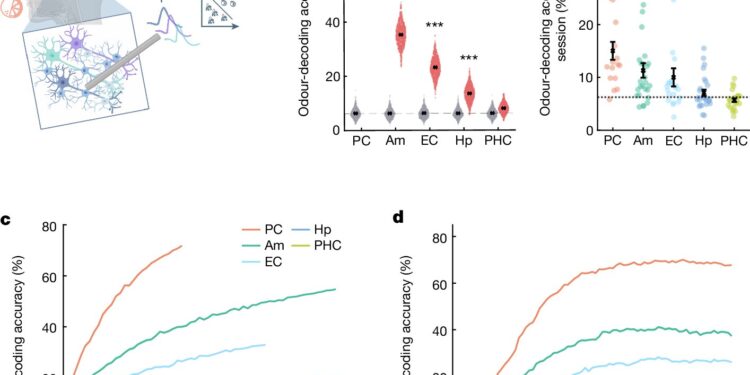Neural activity decodes the identity of the odor. Credit: Nature (2024). DOI: 10.1038/s41586-024-08016-5
We often only realize the importance of our sense of smell when it is no longer there: food no longer tastes good or we no longer react to dangers like the smell of smoke. Researchers from the University Hospital Bonn (UKB), the University of Bonn and the University of Aachen have studied the neural mechanisms of human odor perception for the first time.
Individual nerve cells in the brain recognize odors and respond specifically to the smell, image and writing of an object, for example a banana. The results of this study fill a long-standing knowledge gap between animal and human odor research and have now been published in the journal Nature.
Imaging techniques such as functional magnetic resonance imaging (fMRI) have already revealed which regions of the human brain are involved in olfactory perception. However, these methods do not allow us to study smell at the fundamental level of individual nerve cells.
“Therefore, our understanding of odor processing at the cellular level is mainly based on animal studies, and it is not clear to what extent these results can be transferred to humans,” explains co-corresponding professor Florian Mormann from the Department of Epileptology at UKB, which is also a member of the Transdisciplinary Research Area (TRA) “Life and Health” at the University of Bonn.
Nerve cells in the brain identify smells
Professor Mormann’s research group succeeded for the first time in recording the activity of individual nerve cells during the sense of smell. This was only possible because the researchers worked with patients at the UKB Epileptology Clinic, one of the largest epilepsy centers in Europe, who had electrodes implanted in their brain for diagnostic purposes. They were presented with both pleasant and unpleasant odors, such as those of old fish.
“We discovered that certain nerve cells in the human brain respond to odors. Thanks to their activity, we were able to accurately predict which odor was smelled,” explains first author Marcel Kehl, doctoral student at the University of Bonn in Prof. Mormann’s working group at UKB.
The measurements showed that different brain regions, such as the primary olfactory cortex, anatomically called the piriform cortex, as well as certain areas of the medial temporal lobe, including the amygdala, hippocampus and entorhinal cortex, are involved in specific tasks. .
While nerve cell activity in the olfactory cortex most accurately predicted which odor was smelled, neuronal activity in the hippocampus was able to predict whether odors were correctly identified. Only nerve cells in the amygdala, a region involved in emotion processing, reacted differently depending on whether an odor was perceived as pleasant or unpleasant.
Nerve cells respond to the smell, image and name of banana
In a next step, the researchers investigated the link between odor perception and images. To do this, they presented the participants of the Bonn study with the corresponding images for each odor, for example the odor and later a photo of a banana, and examined the reaction of the neurons. Surprisingly, nerve cells in the primary olfactory cortex respond not only to smells, but also to images.
“This suggests that the task of the human olfactory cortex goes far beyond the pure perception of odors,” says co-corresponding professor Marc Spehr from the Institute of Biology II at RWTH Aachen University .
The researchers discovered individual nerve cells that responded specifically to the smell, image and writing of bananas, for example. This finding indicates that semantic information is processed very early in human olfactory processing. The results not only confirm decades of animal studies, but also show how different brain regions are involved in specific human odor processing functions.
“This is an important contribution to decoding the human olfactory code,” says Professor Mormann. “Further research in this area is needed to one day be able to develop olfactory aids that we can use every day as naturally as glasses or hearing aids.”
More information:
Marcel S. Kehl et al, Single-neuron representations of odors in the human brain, Nature (2024). DOI: 10.1038/s41586-024-08016-5
Provided by University Hospital Bonn
Quote: Another step towards decoding smell: Investigating the neural mechanisms of human odor perception (October 9, 2024) retrieved October 9, 2024 from
This document is subject to copyright. Except for fair use for private study or research purposes, no part may be reproduced without written permission. The content is provided for informational purposes only.



